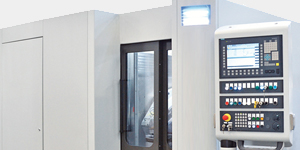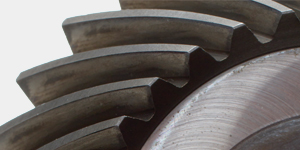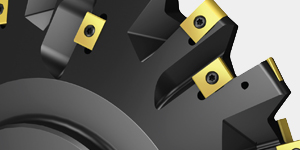Possibility of the generation of an involute gear tooth profile by means of a hob is considered in this article. The consideration is focused on the application of hobs having an extremely small tooth profile angle, namely, by means of hobs with a tooth profile angle of a zero value (φt.ct = 0°). Hobs for semi-finishing/finishing of hardened gears are chosen as an example of the potential area of application of the mentioned feature of gear cutting tools of this particular design. Hobs with a reduced profile angle, φt.ct, feature shortened lateral cutting edges (of a zero length). Placement of cutting elements of a small size made up of super-hard materials becomes possible when the length of lateral cutting edges of the hob approaches zero. Independence from one another of the cutting wedge geometry at the top cutting edge and of the lateral cutting edge is another useful feature of the hob design under consideration, as this feature entails a higher tool-life of the gear-cutting tool.
Preamble
Hardened gears are extensively used in a variety of industries for transmitting power (rotation and torque) from an input shaft to an output shaft. In most cases, the shafts are parallel to one another. Typically, these are high-power-density gears (HPD — gears) that operate at a high RPM. The gears feature high surface hardness up to HRC 62…64, and need to be finished to a high level of accuracy. Commonly, roughly hobbed gears feature carburized tooth flank, which then undergo hardening. Semi-finishing and/or finishing of hardened gears is a challenging problem for present-day production technology.

1 Introduction
After been carburized and hardened, gears get significant deflections of the gear body. This entails linear and angular displacements of involute tooth flanks from their desirable position and orientation. To eliminate the displacements, the gear tooth flanks are ground. Depending on the design parameters of the gear, the grinding of involute gear tooth flanks may take up to two months.
The stock from the gear tooth flanks can be removed by means of the special purpose hob. The hob features very short cutting edges, that makes possible to manufacture the cutting elements of the hob of super-hard materials (borazon, diamonds, and so forth).
2 Basic Rack with Profile Angle of a Zero Value
When involute gears are machined with the gear hob, their involute tooth profile is generated by the so-called basic rack (sometimes, the basic rack is also called the auxiliary generating rack/surface of the hob). Basic rack can be thought of as the zero thickness film of a straight sided rack that is properly meshed with the gear being machined. Commonly equal to φt.ct = 20°, the rack tooth profile angle may vary and can be reduced to φt.ct = 0°. An example of basic rack with the profile angle of a zero value is shown in Figure 1. The design of the basic rack with profile angle of a zero value is commonly specified in terms of the tooth addendum, at.ct (=0°); the tooth dedendum, bt.ct (=ht.ct); the whole tooth height, ht.ct (= at.ct + bt.ct); the tooth thickness, Sct; the space width, Wct; the base pitch of the rack teeth, pb; and the tooth profile angle, φt.ct (=0°).

In the gear machining process, the basic rack, RT, (the auxiliary generating rack), is configured in relation to the work-gear as shown in Figure 2. Opposite profiles of the tooth space of the gear being machined are generated by two points, A and B – the corresponding corners of the basic rack tooth. Opposite profiles of the tooth space of the gear being machined are generated by two points, C and D – the corresponding corners of two adjacent basic rack teeth. P is the pitch point in the gear machining mesh.
3 Hob for Semi-Finishing/Finishing Hardened (Rockwell Hardness up to HRC 62…64) Gears
Having the basic rack, RT, with profile angle of a zero value (φt.ct = 0°) properly configured in the gear machining mesh, one can proceed with the analysis of design parameters of the hob for semi-finishing/finishing hardened gears.
Hardened gears having a surface hardness up to HRC 62…64 are extensively used in the design of turbine reducers, helicopter transmissions, and so forth. For high productive semi-finishing and/or finishing of hardened gears, special purpose hobs are proposed [15, 16].
Chip removal from a hardened gear tooth surface becomes possible if a built-up hob with cutting edges made of super-hard materials (borazon, man-made diamond, and so forth) is used for this purpose. Because of inevitable limitations imposed by the synthesizing process of super-hard materials, cutting elements of only a small size can be synthesized in an economical way. The available size of cutting elements is far from being implemented in the design of standard gear hobs of medium and/or coarse pitch. In order to make possible the use of super-hard materials in the design of gear cutting tools, a special-purpose gear hob design is proposed. (In the 1970s, extensive research on the design and implementation of special-purpose hobs for cutting hardened gears was undertaken by Dr. Oleg I. Moiseyenko (Kyiv, Ukraine)) See Figure 3.

The profile angle, φt.ct, of the auxiliary generating rack, RT, of the gear hob is equal to zero (φt.ct = 0°). The pitch line of the auxiliary rack, RT, is tangent to the base cylinder, db.g, of the gear being machined. When hobbing, the base cylinder, db.g, serves as the pitch cylinder, dw.g, of the gear; therefore, the equality, dw.g = db.g, is observed in the gear hobbing process.
The hob is composed of two semi-hobs. The semi-hobs are separated from one another by the spacer (by the distance ring).
The total length, L, of the active portion of the line of action is equal (Equation 1):

The similar expression (in Equation 2):

is valid for the inner portion, l, of the line of action (see Figure 3).

Here, in Equation 1 and Equation 2, the outer diameter of the gear is designated as do.g, the base diameter of the gear is designated as db.g, and the limit diameter of the gear is designated as dl.g. Equations 1 and 2 yield a formula (Equation 3): for the calculation of the length, lc.t, of the active part of the hob.
The pitch helix angle, ψct, of the hob can be specified in two ways:
First, the angle, ψct, is equal (see Figure 4) [17] (Equation 4):

Second, that same angle, ψct, can be expressed in terms of other design parameters of the hob and of the gear (Equation 5) to be machined (see Figure 4):

Equations 4 and 5 specify that same pitch helix angle, ψct. The equations allow for a formula (Equation 6):

for the calculation of the axial pitch, Px.ct, of the hob helix.
Then, Equation 4, considered together with Equation 6, yields an expression (Equation 7) [17]:

for the calculation of the pitch helix angle, ψct.
As the hob profile angle is zero (φt.ct = 0°), in the case under consideration the setting angle of the hob, ζct, is equal to the pitch helix angle, ψct. This statement correlates with Equation 8:

for the calculation of the base helix angle, ψb.ct, earlier proposed by Prof. S.P. Radzevich [16].
The design of the gear hob makes possible the use of cutting elements with short cutting edges for hobbing gears of any desired coarse pitch. Another advantage is the geometry of the cutting edge, which is independent from the kinematics of meshing. Due to that, the gear hob can be designed with optimal geometry of the cutting edge.
Internal gears can be hobbed this way as well.
Taken as a whole, the use of the hob (see Figure 3) allows for the high productive machining of hardened gears.

4 Worm-Type Gear Semi-Finishing/Finishing Tool with Continuous Helix-Spiral Cutting Edge
A worm-type gear semi-finishing tool having continuous helix-spiral cutting edge can be designed on the premise of a basic rack with a profile angle of a zero value.
For most gear cutting tools of conventional design, the rotation of the cutting tool contributes most to the cutting speed. From this standpoint, the rest of the elementary motions of the gear cutting tool in relation to the work gear are of minor importance. The parameters of the external spatial gear machining mesh can be set up so as to make the rolling motion of the cutting tool the primary motion. In this particular case of special-purpose gear cutting tool design, a minor motion can be the most beneficial. For example, consider a worm-type cutting tool having the continuous helix-spiral cutting edge (further, continuous HS — cutting edge, for simplicity). This design of gear cutting tool is intended for the semi-finishing/finishing of involute gears.
Figure 5 depicts an example of a worm-type cutting tool for semi-finishing/finishing an involute gear [1-9] and many others. In that case, the gear cutting tool features a zero normal profile angle, φt.ct = 0°. When the normal profile angle is of a zero value, then the generating surface, RT, reduces to a helix within the cylinder of outer diameter, do.ct. The helix serves as the cutting edge, CE, of the gear semi-finishing/finishing tool.

The rake surface, Rs, is shaped in the form of a screw surface through the helix, CE. It forms the rake angle, γ, with the perpendicular to the work gear tooth flank. No restrictions are imposed on the actual value of the rake angle, γ. Therefore, it can be easily set equal to its optimal value.
The clearance surface, Cs, is also a screw surface through the helix, CE. It forms the clearance angle, α, with the surface of the cut. Again, no restrictions are imposed on the actual value of the clearance angle, α; thus, it can be easily set equal to its optimal value.
The inclination angle, γ, is large. In this case, the actual value of the inclination angle, γ, strongly depends upon the number of starts of the gear semi-finishing/finishing tool. The greater the number of starts, the more reasonable value of the inclination angle, γ, and vice versa.
When machining a work gear, the gear semi-finishing/finishing tool is set up so that the line of action is aligned with the top land of the auxiliary generating rack, RT. Consequently, the pitch diameter of the gear semi-finishing/finishing tool is equal to its outer diameter, do.c.
The generation of the work gear tooth flank begins at a start point, ace. The start point, ace, is at a certain distance, l, from the pitch point, P. In Figure 5, the length of the active portion of the line of action is designated as lct. After the design parameters of the work gear are specified, then the length of both straight-line segments, l and lct, can be calculated from Figure 5.
When finishing, the work gear is rotated, ωg, about its axis of rotation, Og. The gear semi-finishing/finishing tool is rotated, ωct, about its axis of rotation, Oct. Both the rotations are synchronized with one another. Either the work gear or the gear semi-finishing/finishing tool is fed in the axial direction of the work gear. (This motion is not shown in Figure 5.)
The rolling motion of the gear semi-finishing/finishing tool in relation to the work gear is used as the primary motion, that is, the rolling motion is used as the cutting speed motion, Vcut. The use of a multiple-start gear semi-finishing/finishing tool is preferable from this standpoint.
The reasonable value of stock, t, can be cut from the work gear tooth flank in one tool path. The cut chip flows away from the work gear over the rake surface, Rs, of the gear semi-finishing/finishing tool.

High accuracy of the finished gears can be easily achieved due to peculiarities of design of the gear semi-finishing/finishing tool. No profile errors are inherent because of profiling of the cutting tool. Sharpening the gear semi-finishing/finishing tool does not affect its accuracy; the accuracy of the gear semi-finishing/finishing tool remains constant regardless of how many times the tool has been sharpened. The total tool life of the gear semi-finishing/finishing tool (further gear S-F/F tool) can be significantly extended because of the theoretically unlimited number of sharpening allowed.
Additionally, the gear semi-finishing/finishing tool is easy in production.
Applications of the gear S-F/F tool (see Figure 5) are limited to involute gears with large tooth counts. Only work gears having base diameter, db.g, that is smaller compared to the form diameter, dl.g, can be finished with the gear S-F/F tool, that is, the inequality, db.g < dl.g, needs to be fulfilled. The greater the difference between the diameters, db.g and dl.g, the better the conditions for use of the gear S-F/F tool. This means that work gears with larger tooth counts are preferable for semi-finishing/finishing with the gear S-F/F tool.
The continuous HS — cutting edge of the gear S-F/F tool is in permanent contact with the work gear tooth flank at a distinct point. In the rolling motion, this point generates the tooth profile of the work gear. This schematic makes possible the semi-finishing/finishing of both, external and internal gears, as well with same gear S-F/F tool with no changes (or with limited changes) to the design parameters of the gear S-F/F tool.
In transverse section of the work gear by a plane, the tooth profile is generated by a point, specifically, by the point of intersection of the cutting edge with the traverse section.
The gear S-F/F tool is capable of semi-finishing/finishing only one side of the work gear tooth profile. For semi-finishing/finishing the opposite side of the tooth profile, the work gear needs to be inverted.
The concept of the worm-type gear S-F/F tool can be traced back to 1978, when a design of a worm-type semi-finishing/finishing tool for burnishing of involute gears was proposed [10]. Gear semi-finishing/finishing tools of this design [11] feature a working land and a calibrating land as shown in Figure 6. The gear S-F/F tool works in much the same way as other worm-type gear S-F/F tools (see Figure 5). The rolling motion of the gear burnishing tool contributes primarily to the machining speed, Vmch. The working land deforms the stock while the calibrating land finishes the work gear tooth flank to the required size. This concept is widely used in numerous designs of gear S-F/F tools for burnishing of tooth flanks of involute gears [10, 12, 13, 14, 18], [SU Pat. No.: 795677, 795678, 829280, 880589, 880590, 923688, 956114, 965582, 969395, 980905, 996016, 1016004, 1031610, 1055578, 1174139, 1230019, 1328042], and others.
In summary, gear S-F/F tools (see Figure 6) can be used for burnishing of tooth flanks of work gears with a large tooth number (the requirement db.g < dl.g must be fulfilled). The use of multiple-start gear S-F/F tools is preferred.

These tools are simple in production, and a high degree of accuracy in the work gear tooth flank can be achieved with them.
It is instructive to note here that, according to the author’s recent findings, years ago Dr. Wildhaber was close to developing a gear cutting tool for semi-finishing/finishing involute gears. As early as 1930, he filed an invention [20], titled as “Rotary Gear Cutting Tool.” In this invention, Dr. Wildhaber intended to use the rolling motion as the primary motion in the gear semi-finishing/finishing process. The core idea of the invention is illustrated in Figure 7. In the invention, pitch point, P, in gear semi-finishing/finishing process is on the intersection of the center line,CL, by the pitch circle of a diameter, dg, that is, the pitch point, P, is in between the circles of the outer diameter, do.g, and the end of active profile diameter, dg.l, of the gear.
The pitch point, Pla, has to be inside the circle of the diameter, dg.l, in order to cut chip by the left-side tooth profile of the rotary gear cutting tool. Similarly, the pitch point, Prs, has to be outside the circle of the outside diameter, do.g, in order to cut chip by the left-side tooth profile of the rotary gear cutting tool. Under no circumstances should the pitch circle be allowed to be in between the circles of the diameters, dg.l and do.g. This constraint is because, at the pitch point, the cutting velocity alters its direction in the opposite direction. No gear machining mesh with two pitch points, Pls and P`, simultaneously are feasible. Therefore, the proposal by Dr. Wildhaber “Rotary Gear Cutting Tool” [19], is not workable. However, the concept of the invention is insightful.
Conclusion
In this article, it is shown that the generation of an involute gear tooth profile by means of a hob with a profile angle of a zero value is possible. The consideration is focused on the application of hobs having an extremely small tooth profile angle, namely, by means of hobs with a tooth profile angle of a zero value (φt.ct = 0°). Hobs for semi-finishing/finishing of hardened gears are chosen as an example of the potential area of application of the mentioned feature of gear cutting tools of this particular design. Hobs with a reduced profile angle feature shortened lateral cutting edges (of a zero length). The placement of cutting elements of a small size made up of super-hard materials becomes possible when the length of lateral cutting edges of the hob approaches zero.
Having the cutting wedge geometry at the top cutting edge and the lateral cutting edge being independent from one another is another useful feature of the hob design under consideration, as this feature entails a higher tool-life of the gear cutting tool.
Internal gears can be hobbed this way as well.
Based on the disclosed approach, gear cutting tools can be designed for semi-finishing/finishing gears that operate on intersecting axes ( gearing), and on crossing axes ( gearing).
References
- Radzevich, S.P., A Conical Cutting Tool for Machining Cylindrical Gears, Pat. No. 1028451, USSR, Int. Cl. B23f 21/16, Filed: April 26, 1982.
- Radzevich, S.P., A Gear Cutting Tool, Pat. No. 933316, USSR, Int. Cl. B23f 21/00, Filed: October 18, 1979.
- Radzevich, S.P., A Tool for Machining Gears. Pat. No. 933316, USSR, Int. Cl. B23F 21/00, Filed: October 18, 1979.
- Radzevich, S.P., A Gear Finishing Tool. Pat. No. 1004030, USSR, Int. Cl. B23f 21/16, Filed: April 16, 1981.
- Radzevich, S.P., A Gear Finishing Tool. Pat. No. 1106609, USSR, Int. Cl. B23f 21/16, Filed: September 27, 1982.
- Radzevich, S.P., A Gear cutting Tool. Pat. No. 1028451, USSR, Int. Cl. B23F 21/16, Filed: April 26, 1982.
- Radzevich, S.P., A Gear Finishing Tool. Pat. No. 1151392, USSR, Int. Cl. B23f 21/16, Filed: February 15, 1982.
- Radzevich, S.P., A Gear Finishing Tool. Pat. No. 795677, USSR, Int. Cl. B21h 5/00, Filed: January 15, 1979.
- Radzevich, S.P., A Gear Finishing Tool. Pat. No. 1230019, USSR, Int. Cl. B21h 5/00, Filed: December 25, 1984.
- Radzevich, S.P., A Worm-Type Finishing Tool for Reinforcement of Involute Gear by Surface Plastic Deformation, Pat. No. 829280, USSR, Int. Cl. B21h 5/00, Filed: on May 15, 1978.
- SU Pat. No. 829280, A Worm-Type Finishing Tool for Burnishing Involute Gear./ S.P. Radzevich, Int. Cl. B21h 5/00, Filed: May 5, 1978.
- Radzevich, S.P., A Conical Tool for Finishing Cylindrical Gears, Pat. No. 880590, USSR, Int. Cl. B21h 5/02, Filed: November 6, 1979.
- Radzevich, S.P., A Method of Grinding and Re-Grinding of a Gear Finishing Tool, Pat. No. 956114, USSR, Int. Cl. B21h 5/00, Filed: March 18, 1980.
- Radzevich, S.P., A Tool for Finishing Internal Gear, Pat. No. 880589, USSR, Int.Cl. B21h 5/02, Filed: November 6, 1979.
- Radzevich, S.P., Cutting Tools for Machining of Hardened Gears, Moscow, VNIITEMR, 1992, 60 pages.
- Radzevich, S. P., Design and Investigation of Skiving Hobs for Finishing of Hardened Gears, Ph.D. thesis, Kiev Polytechnic Institute, Kiev, 1982, 298 pages.
- Radzevich, S.P., Theory of Gearing: Kinematics, Geometry, and Synthesis, 3rd Edition, revised and expanded, CRC Press, Boca Raton, FL, 2022, 1208 pages.
- Radzevich, S.P., Palaguta, V.A., A Tool for Finishing Cylindrical Gears, Pat. No. 1328042, USSR, Int. Cl. B21h 5/00, Filed: December 3, 1985.
- U.S. Patent No. 1.924.476, Method of Cutting Gears, Ernst Wildhaber, Filed: March 19, 1928, Patented: August 29, 1933.
- U.S. Patent No. 1.996.987, Rotary Gear Cutting Tool, Ernst Wildhaber, Filed: June 23, 1930, Patented: April 9, 1935.
Bibliography
- Radzevich, S.P., (Editor), Advances in Gear Design and Manufacture, CRC Press, Boca Raton, Florida, 2019, 549 pages.
- Radzevich, S.P., “An Examination of High-Conformal Gearing”, Gear Solutions, February, 2018, pages 31-39.
- Radzevich, S.P., “Design Features of Perfect Gears for Crossed-Axes Gear Pairs”, Gear Solutions magazine, February, 2019, pp. 36-43.
- Radzevich, S.P., (Editor), Dudley’s Handbook of Practical Gear Design and Manufacture, 4th edition, CRC Press, Boca Raton, FL, 2021, 1170 pages, 718 B/W Illustrations.
- Radzevich, S.P., “Envelopes in Gearing: A Novel Accomplishment in the Classical Differential Geometry”, Chapter 8 in: Gear Accuracy: A Treatise on Gear Noise Excitation, Vibration Generation, and Dynamics of Operation, S.P. Radzevich (Editor), Springer, 2025. (in press).
- Radzevich, S.P., Gear Cutting Tools: Science and Engineering, 3rd Edition, CRC Press, 2024, 637 pages. ISBN-10: 1032856432, ISBN-13: 978-1032856438.
- Radzevich, S.P., Geometry of surfaces: A Practical Guide for Mechanical Engineers, 2nd edition, Springer International Publishing, 2019, © Springer Nature Switzerland AG (2020), XXVI, 329 pages, 182 illustrations.
- Radzevich, S.P., High-Conformal Gearing: Kinematics and Geometry, 2nd edition, Elsevier, Amsterdam, 2020, 506 pages.
- Radzevich, S.P., “Knowledge (of Gear Theory) is Power in the Design, Production, and Application of Gears,” Gear Solutions magazine, August 2020, pages 38-44. [A file in .pdf format with this article can be requested from the author (at no charge)]. A reprint of the article can be found out in: Radzevich, S.P., “Poor Understanding of the Scientific Theory of Gearing by the Majority of Gear Scientists and Engineers,” Chapter 9, pages 193-214 in: Radzevich, S.P., Novikov/Conformal Gearing: Scientific Theory and Practice, Springer, 2022, 526 pages.
- Radzevich, S.P., Novikov/Conformal Gearing: Scientific Theory and Practice, Springer, 2022 (November 15, 2022), 33+493 (526) pages.
- Radzevich, S.P., (Editor), Recent Advances in Gearing: Scientific Theory and Applications, Springer, 1st ed., 2022 edition (June 25, 2021), 569 pages.
- Radzevich, S.P., “The Commonalities and Differences between Helical “Low-Tooth-Count Gears” and “Multiple-Start Worms”,” Gear Solutions magazine, February 2021, pp. 34-39.
- Radzevich, S.P., Storchak, M.G. (Editors), Advances in Gear Theory and Gear Cutting Tool Design, Springer, 2022, 500 pages.



























